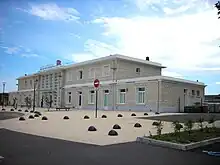Argentan | |
|---|---|
Subprefecture and commune | |
 The château of the dukes in the centre of Argentan | |
.svg.png.webp) Coat of arms | |
Location of Argentan | |
 Argentan 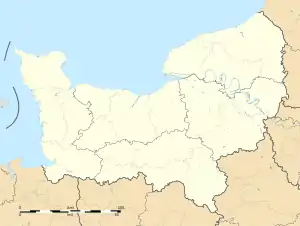 Argentan | |
| Coordinates: 48°45′N 0°01′W / 48.75°N 0.02°W | |
| Country | France |
| Region | Normandy |
| Department | Orne |
| Arrondissement | Argentan |
| Canton | Argentan-1 Argentan-2 |
| Intercommunality | Argentan Intercom |
| Government | |
| • Mayor (2020–2026) | Frédéric Leveillé[1] |
| Area 1 | 18.18 km2 (7.02 sq mi) |
| Population | 13,291 |
| • Density | 730/km2 (1,900/sq mi) |
| Time zone | UTC+01:00 (CET) |
| • Summer (DST) | UTC+02:00 (CEST) |
| INSEE/Postal code | 61006 /61200 |
| Elevation | 152–228 m (499–748 ft) |
| 1 French Land Register data, which excludes lakes, ponds, glaciers > 1 km2 (0.386 sq mi or 247 acres) and river estuaries. | |
Argentan (French pronunciation: [aʁʒɑ̃tɑ̃] ⓘ) is a commune and the seat of two cantons and of an arrondissement in the Orne department in northwestern France.[3] As of 2019, Argentan is the third largest municipality by population in the Orne department.[4]
Geography
The commune of Argentan is made up of the town of Argentan and the following villages and hamlets, La Croix de Coulandon, Coulandon and Mauvaisville.[5]
Argentan has 5 water courses running through it, three rivers The Orne, The Ure and The Baize and two streams, the Marais de Fleuriel and the Fontaines Thiot.[6][7]
Location
Argentan is located 180 km (110 mi) NE of Rennes, 131 km (81 mi) ENE of the Mont Saint-Michel, 188 km (117 mi) SE of Cherbourg, 58 km (36 mi) SSE of Caen, 133 km (83 mi) SW of Rouen and 100 km (62 mi) N of Le Mans. Argentan station has rail connections to Caen, Le Mans, Paris and Granville.[8][7]
History
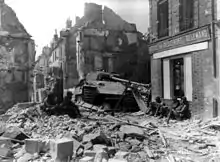
Argentan is situated near the river Orne. Although the region was heavily populated during the Gallo Roman period the town is not mentioned until 1025–1026. The toponym comes from the Gaulish words argentos ("silver") and magos ("market").[9] The town grew in importance during the Middle Ages.
Throughout the Middle Ages, Argentan alternated between prosperity and destruction, as English forces occupied the city several times. The Plantagenets had considered this town as one of the most important of Normandy.
During the reign of Louis XIV, Colbert set Alençon against Argentan in an economic competition on lace making. Thus, the point d'Argentan ("Argentan stitch") and the point d'Alençon ("Alençon stitch") were created. Argentan became a very important town for traditional industry. It also gained in religious importance with the building of a Benedictine Abbey and two churches, Saint-Martin and Saint-Germain. Several mansions (hôtels particuliers) were also built.
During World War I, the French 104th Infantry Regiment/14th Infantry Brigade was stationed at Argentan. It participated in the battle of Verdun in 1916.
During World War II, the city was almost totally destroyed. On 5 June 1944, on the eve of the Allied D-Day landing on the beaches of Normandy, the city suffered an important air raid in which the train station was destroyed.[10] The city suffered further damage when it was bombed on 6 and 7 June by B-17 and B-24 bombers of the U.S. Eighth Air Force.[11] The greatest part of the city was, however, left in ruins two and a half months later, at the end of August, during the battle of the Argentan-Falaise Pocket. The U.S. Third Army, under the command of general George S. Patton liberated Argentan after eight days of violent combat against the German 9th Panzer Division and the 2nd SS Panzer Division Das Reich. The U.S. 80th Infantry Division liberated the city in the morning of 20 August.
Population
|
| |||||||||||||||||||||||||||||||||||||||||||||||||||||||||||||||||||||||||||||||||||||||||||||||||||||||||||||||
| Source: EHESS[12] and INSEE (1968–2017)[13] | ||||||||||||||||||||||||||||||||||||||||||||||||||||||||||||||||||||||||||||||||||||||||||||||||||||||||||||||||
Main sights and notable buildings
- Donjon of Argentan - Ramparts of Argentan built in the Middle Ages by Henri I.[14] It was classed as a Monument historique in 1945.[14]
- Tour Marguerite - a 12th centaury medieval tower built by Henri I.[15] It was classed as a Monument Historique in 1965.[15]
- Castle of the Dukes - a 14th century castle built by Pierre II of Alençon, it is now a court house.[16] it was classed as a monument historique in 1889.[17] The grounds of the castle houses the 14th centaury St. Nicholas Chapel, which is also classed as a monument historique.[18]
- Saint Martin church - built in 16th century it was listed as monument historique in 1862.[19]
- Saint Germain church - 15th century church listed as monument historique in 1889.[20][21]
- Saint Roch Chapel
National Heritage sites
The Commune has a total of 18 buildings and areas listed as a Monument historique in addition to the 6 listed above there are:[7]
- Hotel du Moulin de Fontenelle - 18th Centaury L-shaped Hotel, added as a monument in 2004.[22]
- Former Hotel Servain - 17th Centaury Hotel, whose door was added as a monument in 1948.[23]
- Henri IV House - Built in 1623 it served as the town hall from 1722 to 1809, it was classified in 1946.[24]
- Hôtel Ango-de-la-Motte - Former seventeenth century Hotel, it was classified in 1948.[24]
- Three Crosses Column - erected in 1771, the three crosses are believed to be either to mark the meeting place of three 12th centaury kings, commemorate the expulsion of the English in 1450, or to redeem the vandalism of Theodore Beza in 1563. [25]
- Statue of the Virgin - erected in 1648 it was registered in 1934[26]
- Former residence of the Abbess of the Benedictines - erected in 1623 it was built to receive novices from Almenêches Abbey to replace former nuns who died and those who had opposed the establishment of the new customs of the Reformation. [27] It was registered in 1932.[28]
- Count of Lonlay - former 17th centaury hotel, which was registered in 1948 [29]
- Norman house - 14th centaury house, which was registered in 1948 [30]
- Lemonnier house - 14th centaury house, which was registered in 1948 [31]
- Aumont-de-la-Vente Hotel - former 17th centaury hotel, where James II of England stayed in 1692, during his period of exile. [29] Classed as a Monument historique in 1948.[32]
- Former church of Notre-Dame-de-la-Place - former 12th centaury church for Medieval pilgrims, that was sold in 1820 and became a dwelling house.[33] It became a monument historique in 1986.[34]
Museums
- Maison Des Dentelles Museum dedicated to Argentan lace[35]
- Museum of Fernand Léger – André Mare Museum dedicated to Fernand Léger and André Mare, two major 20th century artists from Argentan[36]
Other points of interest
- Carrière de Belle-Eau is an old quarry for the extraction of sand, that was closed shortly after World War two, which was bought by the commune in 1989.[37] In 1995 the area was turned into a 18 960 m2 nature reserve.[38] The site today hosts nearly 200 different species of flora and fauna, including thyme broomrape, Common parsley frog, Smooth newt and leopard marsh orchid.[38]
Gallery
 Chapel Saint Nicholas – built at the end of the 11th century
Chapel Saint Nicholas – built at the end of the 11th century Hôtel du Moulin de Tercey, 2 rue Saint-Martin
Hôtel du Moulin de Tercey, 2 rue Saint-Martin Donjon of Argentan, built by Henry II of England
Donjon of Argentan, built by Henry II of England Saint Germain church (built 16th–18th centuries)
Saint Germain church (built 16th–18th centuries) Tour Marguerite is the only surviving medieval tower
Tour Marguerite is the only surviving medieval tower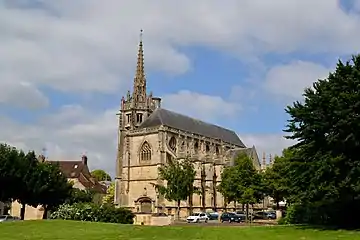 Saint Martin church, built in the 15th and 16th centuries
Saint Martin church, built in the 15th and 16th centuries Hotel Joseph de Laleu 56 rue Saint Martin built in 1651
Hotel Joseph de Laleu 56 rue Saint Martin built in 1651 This hotel particulier was the Nicolas Ango house
This hotel particulier was the Nicolas Ango house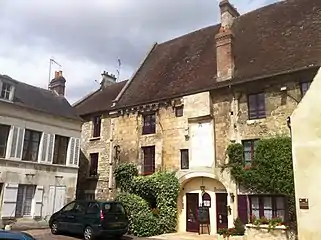 The former abbey, now a restaurant
The former abbey, now a restaurant Château of the Dukes of Alençon (15th century), now the Court House
Château of the Dukes of Alençon (15th century), now the Court House Birthplace of painter André Mare
Birthplace of painter André Mare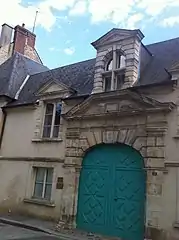 Hôtel du comte de Lonlay
Hôtel du comte de Lonlay
Notable people
- Giles d'Argentan (c. 1280 – 24 June 1314), Norman knight who was killed at the Battle of Bannockburn
- John II, Duke of Alençon (1409-1476), was a French nobleman born here, and best known as a general in the Last Phase of the Hundred Years' War and for his role as a comrade-in-arms of Joan of Arc. [39]
- Margaret of Lorraine (1463 - 1521) - A French noblewoman and a nun of the order of Poor Clares who was beatified in 1921, died here.[40]
- Vincent Muselli (1879-1956) a French writer and poet was born here.[41]
- Fernand Léger (1881–1955), painter was born in Argentan[42]
- André Mare (1885–1935), painter was born in Argentan [43]
- André Rouyer (1929-1994) a French actor was born here.[44]
- François Doubin - (1933 – 2019) a French politician and cabinet minister who lived and died here.[45]
- Gérard Saint (1935-1960) a bike racer who won the Combativity award in 1959 Tour de France was born here.[46]
- Richard Peduzzi (born 1945) a French scenographer was born here.[47]
- Michel Onfray (born 1959), writer and philosopher born here.[48]
- Franck Berrier (1984-2021), a former professional footballer was born here.[49]
Transport
- Argentan station has rail connections to Caen, Le Mans, Paris and Granville.[50]
- Aérodrome d'Argentan is an Aerodrome that was opened in 1946. It's ICAO airport code is LFAJ.[51]
Twin towns – sister cities
 Abingdon-on-Thames, England, United Kingdom
Abingdon-on-Thames, England, United Kingdom Baja, Hungary
Baja, Hungary Rotenburg an der Fulda, Germany
Rotenburg an der Fulda, Germany
See also
References
- ↑ "Répertoire national des élus: les maires". data.gouv.fr, Plateforme ouverte des données publiques françaises (in French). 9 August 2021.
- ↑ "Populations légales 2021". The National Institute of Statistics and Economic Studies. 28 December 2023.
- ↑ "Commune d'Argentan (61006) − COG Insee". www.insee.fr.
- ↑ Populations légales 2019: 61 Orne, INSEE
- 1 2 "Argentan · 61200, France". Argentan · 61200, France.
- ↑ Sandre. "Fiche cours d'eau - L'Orne (I2--0200)".
- 1 2 3 "Monument Historique Argentan - Mairie d'Argentan et sa ville". www.annuaire-mairie.fr.
- ↑ "Distance entre Argentan et les grandes villes et capitales". www.annuaire-mairie.fr.
- ↑ MOULIN, Marie-Anne; CHAVE, Isabelle; FAJAL, Bruno; FOUCHER, Jean-Pascal; et al. (2008). Argentn et ses environs au Moyen Âge: Approche historique et archéologique. Public Library: Conseil général de l'Orne. p. 38. ISBN 978-2-86061-032-2.
- ↑ Destruction of Argentan SNCF train station in August 1944: http://argentan.vapeur.free.fr/gare_guerre.html (French site)
- ↑ Freeman, Roger A., The Mighty Eighth, Motorbooks International, 1981, 1990, pp. 259 & 260.
- ↑ Des villages de Cassini aux communes d'aujourd'hui: Commune data sheet Argentan, EHESS (in French).
- ↑ Population en historique depuis 1968, INSEE
- 1 2 "Ancien donjon à Argentan - PA00110717". monumentum.fr.
- 1 2 "Tour Marguerite à Argentan - PA00110730". monumentum.fr.
- ↑ "Castles.nl - Argentan Ducal Castle". www.castles.nl.
- ↑ "Ancien château des Ducs à Argentan - PA00110715". monumentum.fr.
- ↑ "Ancienne chapelle du château, ou chapelle Saint-Nicolas à Argentan - PA00110714". monumentum.fr.
- ↑ "Eglise Saint-Martin à Argentan - PA00110720". monumentum.fr.
- ↑ "Sight ÉGLISE SAINT-GERMAIN D'ARGENTAN in Argentan, FRANCE". www.belvicci.com.
- ↑ "Eglise Saint-Germain à Argentan - PA00110719". monumentum.fr.
- ↑ "Hôtel du Moulin de Fontenelle à Argentan - PA61000035". monumentum.fr.
- ↑ "Ancien hôtel Servain à Argentan - PA00110725". monumentum.fr.
- 1 2 "Hôtel Ango-de-la-Motte à Argentan - PA00110722". monumentum.fr.
- ↑ "Colonne dite des Trois Croix à Argentan - PA00110716". monumentum.fr.
- ↑ "Statue de la Vierge à Argentan - PA00110729". monumentum.fr.
- ↑ "Ancienne habitation de l'Abbesse des Bénédictines à Argentan - PA00110721". monumentum.fr.
- ↑ "Ancienne habitation de l'Abbesse des Bénédictines". www.pop.culture.gouv.fr.
- 1 2 "Ancien hôtel du comte de Lonlay à Argentan - PA00110724". monumentum.fr.
- ↑ "Maison normande à Argentan - PA00110727". monumentum.fr.
- ↑ "Maison Lemonnier à Argentan - PA00110726". monumentum.fr.
- ↑ "Ancien hôtel d'Aumont-de-la-Vente". www.pop.culture.gouv.fr.
- ↑ "Old church of Notre-Dame de la Place". Observetaire du patrimoine religieux.
- ↑ "Ancienne église Notre-Dame-de-la-Place à Argentan - PA00110718". monumentum.fr.
- ↑ "Maison des Dentelles d'Argentan". Triplancar. 20 July 2016.
- ↑ "Musée Fernand Léger - André Mare ARGENTAN". Normandie Tourisme.
- ↑ "Un chantier bénévole pour entretenir la carrière-refuge de Belle-Eau, à Argentan". actu.fr. 27 February 2021.
- 1 2 "Carrière de Belle-Eau".
- ↑ Potter, David (1995). Keen, Maurice (ed.). A History of France, 1460–1560: The Emergence of a Nation State. Macmillan. p. 375.
- ↑ "CATHOLIC ENCYCLOPEDIA: Blessed Margaret of Lorraine". www.newadvent.org.
- ↑ Larousse, Éditions. "Vincent Muselli - LAROUSSE". www.larousse.fr.
- ↑ "Fernand Léger | Cubist, Modernist Painter & Sculptor | Britannica". www.britannica.com.
- ↑ "Andre Mare". belovedlinens.net.
- ↑ "André Rouyer | Actor, Writer". IMDb.
- ↑ "François Doubin, ancien maire d'Argentan et ancien ministre, est décédé". Ouest-France.fr. 18 June 2019.
- ↑ "Argentan. Dimanche, c'est le critérium Gérard-Saint". Ouest-France.fr. 16 September 2022.
- ↑ "Richard Peduzzi | Production Designer, Art Department". IMDb.
- ↑ "Michel Onfray - Freedom From Religion Foundation". ffrf.org.
- ↑ "Football. Le Normand Franck Berrier, icône en Belgique, est décédé tragiquement". Ouest-France.fr. 13 August 2021.
- ↑ Plan du réseau, TER Normandie, accessed 24 September 2023.
- ↑ "Argentan - France". World Airport Codes.
- ↑ "Villes jumelées". argentan.fr (in French). Argentan. Retrieved 23 April 2021.
